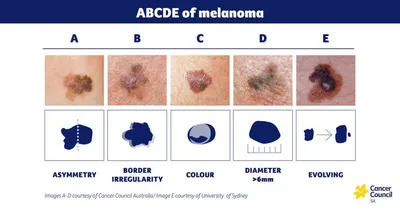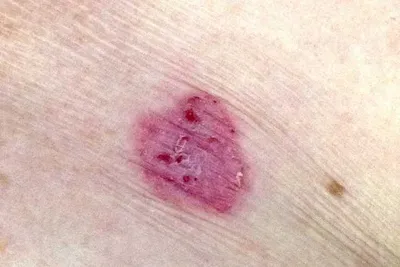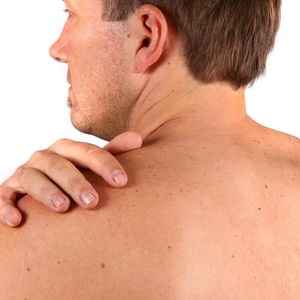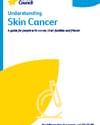Skin cancer spots to watch
There are three common skin cancer types, which are named after the type of skin cell in which the cancer develops. These include:
Melanoma
Melanoma is the least common, but most dangerous type of skin cancer. Most skin cancer deaths are from melanoma. It is often fast growing and can spread to other parts of the body where it can form a secondary cancer.
Melanoma is typically a new spot or an existing spot that changes in colour, size or shape. They are often uneven in colour with an irregular shape or border.
These can develop anywhere on the body, even on areas not exposed to sunlight.
The ABCDE of melanoma is a useful guide when you’re checking your skin for any unusual spots or changes:
- A is for asymmetry – A spot that isn’t symmetrical. If a line was drawn down the middle, the two sides wouldn’t match up.
- B is for border – A spot with an irregular, blurry or jagged edge.
- C is for colour – A spot that is blotchy with a number of colours such as black, blue, red, white and/or grey.
- D is for diameter – A spot that is getting bigger or is larger than six millimetres.
- E is for evolving – A spot that is changing or growing.
Basal cell carcinoma
Basal cell carcinoma is the most common type of skin cancer. It grows slowly over months and years and may damage nearby tissues and organs if left untreated.
These types of skin cancers usually look red, pale or pearly in colour and may ulcerate and fail to heal. It can appear as a dry, scaly area.
Squamous cell carcinoma
Squamous cell carcinoma is less common than basal cell carcinoma but grows faster. It may spread to other parts of the body if left untreated. This kind of skin cancer is likely to develop on skin most often exposed to the sun, such as the face and the forearms.
This type of skin cancer often looks like a thickened, red, scaly spot that might bleed easily, crust and fail to heal.
Watch our video for more tips to spot skin cancer:
How to check my skin for cancer
Everyone can check their own skin for signs of skin cancer, and with a bit of practice, it can take no longer than 15 minutes.
When you examine your skin:
- check your whole body, as skin cancers can sometimes appear in areas we might not expect — like the soles of your feet, between your fingers and toes, or even under your nails
- use a mirror, such as a full-length mirror and a hand-held mirror
- undress completely in a well-lit room
- ask someone you trust to help with any hard to see spots.
Checking your skin doesn’t have to be complicated but it’s helpful to check it regularly for new spots or changes. Use the steps below to guide you and make sure you check your whole body.
Step 1: Check your face, head and neck
- Check your whole face including around the nose, lips and ears.
- Look over your scalp closely.
- Use a hand-held mirror to check behind your ears, underneath your jaw and the back of your neck.
Step 2: Check your torso – front, back and sides
- Raise your arms and look at your right and left side.
- Turn your back to the full-length mirror to check the back of your shoulders, upper back, upper arms and lower back.
- Women also need to check under their breasts.
Step 3: Arms and hands
- Look at both your palm and back of your hands.
- Check between fingers and under your fingernails. If you usually wear nail polish, remove your nail polish and look for spots in your nail bed.
- Face a full-length mirror and look at your forearms and upper arms. Bend elbows to look at the undersides.
Step 4: Legs, buttocks and feet
- Check the front and back of the thighs, lower legs and ankles.
- Use the full-length mirror to check your buttocks and genitals.
- Check the top of both of your feet, toes, toenails and spaces between the toes. Use a hand-held mirror to look at the sole or bottom of your foot. Sitting on a chair may make this easier.
What should I do if I spot something that looks like skin cancer?
If you see anything on your skin that has changed in size, shape or colour, that itches or bleeds, or that you don’t think was there before, see your local doctor as soon as possible.
Your regular doctor will know your full history and can examine your skin and advise you regarding appropriate care. It is also a good idea to talk to your doctor about your level of risk for skin cancer and for advice on early detection.
If you don’t have a regular doctor, make an appointment to see any doctor; they are all trained to examine skin cancer.
If you would like a second opinion, ask your doctor to refer you to a dermatologist or doctor who has completed additional skin cancer training. Your doctor may suggest you see a specialist anyway.
Where can I go for my skin check?
In addition to regularly self-checking your skin, Cancer Council SA recommends seeing your local doctor if you notice any changes to your skin that are unusual.
The doctors listed below have completed additional training, to help detect and treat skin cancer early.
Cancer Council SA has awarded more than 200 dermatoscopes, (a specialised hand-held magnifying device), to doctors across South Australia, including regional areas, and where there are higher rates of skin cancer.
If you would like to make an appointment with any of the doctors or practices listed below that have been awarded a dermatoscope, please contact them directly.
Metropolitan Adelaide
Aberfoyle Park Medical Centre
Adelaide Health Care
43 Carrington St, Adelaide 5000
Ph. (08) 8410 0774
Adelaide Medical Solutions Woodville
Adelaide Road Clinic
AHA Seaford Meadows Day and Night Practice
2/20 Prow Dr, Seaford Meadows 5169
Ph. (08) 8327 2033
Belair Medical Clinic
20 Main Rd, Belair 5052
Ph. (08) 8279 7600
Blackwood Clinic
23 Coromandel Pde, Blackwood 5051
Ph. (08) 8278 6666
Blackwood Family Medical Centre
Castle Medical Centre
33 Raglan Ave, Edwardstown 5039
Ph. (08) 7095 7999
Choice of Living Health Centre
Christies Beach Medical Centre
Diabetes Base Camp
2/80-86 Anzac Hwy, Everard Park 5035
Ph. (08) 8166 2418
Dulwich Family Practice
Elizabeth Family Health Care
16 Playford Blvd, Elizabeth 5112
Ph. (08) 7485 4000
Firle Medical Centre
Golden Grove Family Health
1/205 The Golden Way, Golden Grove 5125
Ph. (08) 8289 1222
Gouger Street Medical Centre
122 Gouger St, Adelaide 5000
Ph. (08) 8231 5124
Hallett Cove Corner Surgery
Hanson Road Medical Clinic
Health Matters Medical Centre
Hindmarsh GP
275 Port Rd, Hindmarsh 5007
Ph. (08) 8340 2233
Hutt Street General Practice
Integrative Health Solutions
Kensington Park Medical Practice
84 Shipsters Rd, Kensington Park 5068
Ph. (08) 8332 4077
Magill Family Practice
Malvern Medical Centre
Mawson Lakes Healthcare Complex
50 Mawson Lakes Blvd, Mawson Lakes 5095
Ph. (08) 8359 6266
Mawson Lakes Medical Centre
Medical HQ Athelstone
296 Gorge Rd, Athelstone 5076
Ph. (08) 8336 7333
Medical HQ Glynde
Morphett Vale Family Practice
Para Hills 365 Days Medical Centre
Paradise Medical Centre
Pasadena Medical
Pear Tree Family Practice
16 Partridge St, Glenelg 5045
Ph. (08) 7228 5818
Pioneer Medical Centre
Pro Health Care North Adelaide
118 Barnard St, North Adelaide 5006
Ph. (08) 8361 8807
Pro Health Care Norwood
Prospect Medical Centre
Refugee Health Service
Regency Medical Clinic
517 Regency Rd, Sefton Park 5083
Ph. (08) 8269 1900
Re:You Health
Level 3, 141 Hutt St, Adelaide 5000
Ph. (08) 8448 1915
Rose Street Clinic
Russell Clinic
202 Main Rd, Blackwood 5051
Ph. (08) 8278 1111
Skin Wise Healthcare
377 Payneham Rd, Marden 5070
Ph. (08) 8230 6999
Southcare Medical Services Christies Beach
Southcare Medical Services Sheidow Park
5 Commercial Rd, Sheidow Park 5158
Ph. (08) 8322 2455
Tea Tree Medical Centre
Tranmere Village Medical Centre
164 Glynburn Rd, Tranmere 5073
Ph. (08) 8365 1157
UniSA Medical Clinic - City East
L2 Centenary Building, Frome St, Adelaide 5000
Ph. 1300 172 996
UniSA Health Clinic - City West
27 North Tce, Adelaide 5000
Ph. 1300 172 996
Vitality Healthcare Medical Centre
Welland Medical Centre
West Beach Medical
Western Clinic Medical Centre
152-154 Henley Beach Rd, Torrensville 5031
Ph. (08) 8450 2500
Woodcroft Medical Centre
Woodville Family Medical Practice
813 Port Rd, Woodville 5011
Ph. (08) 8445 2618
Outer Metro and Regional South Australia
Angaston Medical Centre
Booleroo Medical Centre
11B Stephens St, Booleroo Centre 5482
Ph. (08) 8667 2046
Bridge Clinic
Dr Jonathan Heng, Dr Katherine Thornton, Dr Elizabeth Gebler-Hughes
8 Standen St, Murray Bridge 5253
Ph. (08) 8539 3232
Bridgeview Family Practice
Central Clinic
Clare Medical Centre
Coober Pedy Medical Practice
89 McDougall St, Coober Pedy 5723
Ph. (08) 8678 9224
Crystal Brook Medical Practice
Ferrers Medical Clinic
Ghan Medical Centre
Goolwa Medical Centre
Goyder's Line Medical Centre
Hamley Bridge Medical Centre
Hawkins Medical Clinic
Dr Emma Greenfield, Dr Rowan Kruysse, Dr Safoan Rahman, Dr Shivani Gulati, Dr Timothy Harrison
30 Sturt St, Mount Gambier 5290
Ph. (08) 8725 5266
Hyde and Partners
1 Light Sq, Gawler 5118
Ph. (08) 8522 3444
Integrative Health Solutions
Kadina Medical Associates
Kangaroo Island Medical Clinic
64 Murray St, Kingscote 5223
Ph. (08) 8553 2037
Kapunda Medical Practice
Lincoln Medical Centre
Littlehampton Medical Centre
89 North Tce, Littlehampton 5250
Ph. (08) 8398 2600
Lobethal Medical Centre
5 Wattle St, Lobethal 5241
Ph. (08) 8389 6364
Mannum Medical Centre
1 Parker St, Mannum 5238
Ph. (08) 8569 0222
Medical HQ Ardrossan
10 Second St, Ardrossan 5571
Ph. (08) 8837 3837
Mill House Medical Centre
Minlaton Medical Centre
Moonta Medical Centre
7-12 Majors Rd, Moonta 5558
Ph. (08) 8825 2309
Mount Compass Medical Centre
Mount Barker Medical Clinic
15-19 Victoria Cres, Mount Barker 5251
Ph. (08) 8391 1300
Mount Barker and Balhannah Medical Clinics
Mount Gambier Family Health
Murray Bridge Day and Night Surgery
Murraylands Medical Centre
Nairne Medical Clinic
Nuriootpa Medical Centre
Pro Health Care Stirling
Rural Skin Cancer Service - Pinnaroo
29 Hensley St, Pinnaroo 5304
Ph. 1300 584 648
Southcoast District Hospital
Southern Fleurieu Family Practice
Strathalbyn Family Medical Practice
Strathalbyn Medical Clinic
Tanunda Medical Centre
13 Mill St, Tanunda 5352
Ph. (08) 8563 2777
Uraidla Family Practice
Victor Medical Centre
11 Torrens St, Victor Harbor 5211
Ph. (08) 8551 3200
Victoria Road Medical Clinic
Village Medical Centre
Wakefield Plains Medical Clinic
Williamstown Medical
If you are using a skin clinic, ask about the expertise of staff, range of services and fee arrangements they provide.
How can I reduce my risk of skin cancer?
The best way to reduce your risk of skin cancer is to use a combination of all five sun protection measures when the UV is 3 and above:
- Slip on clothing that covers as much skin as possible.
- Slop on SPF 50 or 50+ broad-spectrum, water-resistant sunscreen 20 minutes before going outdoors and reapply regularly.
- Slap on a broad-brimmed or bucket hat.
- Seek shade where possible.
- Slide on wraparound sunglasses.
- Learn more about how to protect your skin from skin cancer.
Learn more about how to protect your skin from skin cancer.






